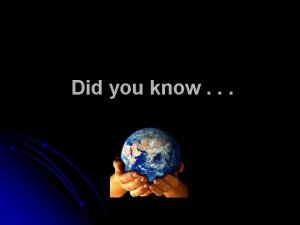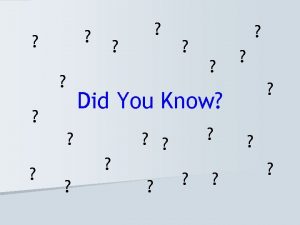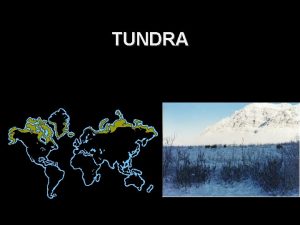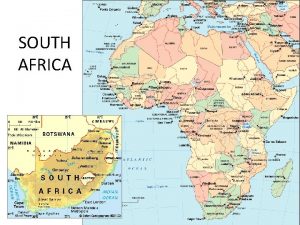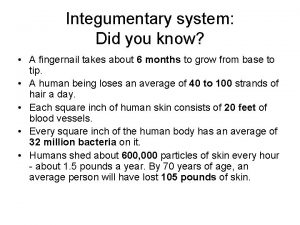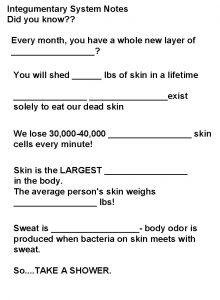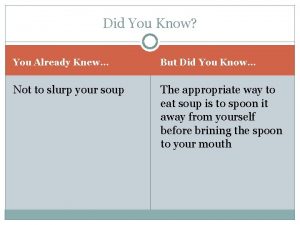Integumentary System Integumentary System Did you know that















- Slides: 15

Integumentary System

Integumentary System § Did you know that you show this system to people everyday? ? ? What exactly is the integumentary system? YOUR SKIN…. . actually it’s more than just your skin. It also includes your hair and your nails.

Integumentary System § Comes from the Latin word “integumentum” which means “ a covering”. The skin covers the body, the hair covers the head and other parts of the body and the nails cover the tops of the fingers and toes.

Integumentary System § Hair is made of strong, dead, protein called keratin. Keratin is the same kind of protein that makes up your nails and the outer layer of your skin.

Integumentary System § Did you know…. . most of the keratin that you come in contact with is actually dead; hair , skin, and nails are all formed from dead skin cells which the body sheds as new cells push up from underneath!!!

Integumentary System § Functions of the integumentary System: PROTECTS: Body’s internal tissues and organs PROTECTS: Against infectious organisms and injury PREVENTS: Against losing body fluids REGULATES: Body Temperature through sweating and regulating peripheral blood flow REMOVES: Waste from the body by means of perspiration ( sweating ) GENERATES: Vitamin D by being exposed to ultraviolet light ( like sunlight )

Integumentary System Functions ( cont. ) § PROTECTS: STORES: Against sunburns from ultraviolet rays. ( sunlight ) Fat for fuel and insulation SENSORY ORGAN: Has receptors that allow us to feel by touch, feel pressure, feel pain, feel heat and cold

Integumentary System SKIN § The skin protects the body, allows us to have a sense of touch and helps keep the body at the right temperature. Did you know: It is the largest sense organ in the body !!!

Integumentary System Skin ( cont. ) § It is made up of three layers: Epidermis: The layer found on the outside. It is only about 30 -60 cells thick. At the bottom of the epidermis, there are new skin cells that are continually forming. As they are forming, the new cells start moving toward the top of the epidermis. This can take anywhere from 2 weeks to a month. As the new cells move up to the top, the older cells near the top will die off and rise to the surface of your skin

Integumentary System Skin ( cont. ) What you see when you look at your skin is really nothing but dead skin cells. Every minute about 30, 000 to 40, 000 dead skin cells are shed off the surface of our skin ( this equates to about 9 lbs. a year. 95% of the cells in the epidermis work to make new skin cells. The other 5% is used to make melanin ( which is what gives skin its color and protects you from getting burned by the sun’s uv rays

Integumentary System Skin (cont. ) Dermis: This layer has nerve endings, blood vessels, hair follicles, sweat glands, and oil glands. It also contains collagen and elastin, which are tough and stretchy. The oil glands make an oily substance known as sebum, that spreads over the epidermis of the skin which keeps it flexible and waterproof. Subcutaneous Layer: Made mostly of fat and is what helps your body stay warm and absorb shocks…. like if you bang into something or fall down. This layer also helps hold your skin to all the tissues underneath it. This is the layer where you will find the start of hair.

Integumentary System SKIN ( cont. )

Integumentary System NAILS Nails protect the tips of the fingers and the toes. They are a form of modified hair. Nails grow from nail roots or beds. These roots areas of rapidly dividing cells. During cell division, nail root cells are filled with protein, keratin, and they become tough and plate-like. There are no nerve endings in nails. Nails grow about 1/10 of an inch (2. 5 mm)/month. It takes about 6 months for a fingernail to grow from cuticle to tip. They grow faster than your toenails do and will grow faster on your dominant hand.

Integumentary System HAIR Each hair on your body grows out of a tiny tube in the skin called a follicle. Hairs are large columns of dead cells that are filled with tough fibrous protein. Hair grows due to rapid cell growth at the base of the hair follicle and the color of hair is determined by the amount of melanin in the skin. You have hair all over the body, except for the lips, the palms of hands, and the soles of your feet. There are more than 100, 000 follicles on the head. Connected to each follicle, in the dermis layer, is a tiny sebacious gland that releases sebum onto the hair. This coats the hair with oil, giving it some shine and waterproofing.

Integumentary System HAIR ( cont. )
 Where did you went
Where did you went Ngoại tâm thu thất chùm đôi
Ngoại tâm thu thất chùm đôi Block xoang nhĩ là gì
Block xoang nhĩ là gì Thơ thất ngôn tứ tuyệt đường luật
Thơ thất ngôn tứ tuyệt đường luật Thơ thất ngôn tứ tuyệt đường luật
Thơ thất ngôn tứ tuyệt đường luật Chiến lược kinh doanh quốc tế của walmart
Chiến lược kinh doanh quốc tế của walmart Tìm vết của mặt phẳng
Tìm vết của mặt phẳng Con hãy đưa tay khi thấy người vấp ngã
Con hãy đưa tay khi thấy người vấp ngã Tôn thất thuyết là ai
Tôn thất thuyết là ai Gây tê cơ vuông thắt lưng
Gây tê cơ vuông thắt lưng Sau thất bại ở hồ điển triệt
Sau thất bại ở hồ điển triệt Teapots history
Teapots history Indirect speech
Indirect speech Do you know minecraft
Do you know minecraft Did you know
Did you know What you did last weekend
What you did last weekend














